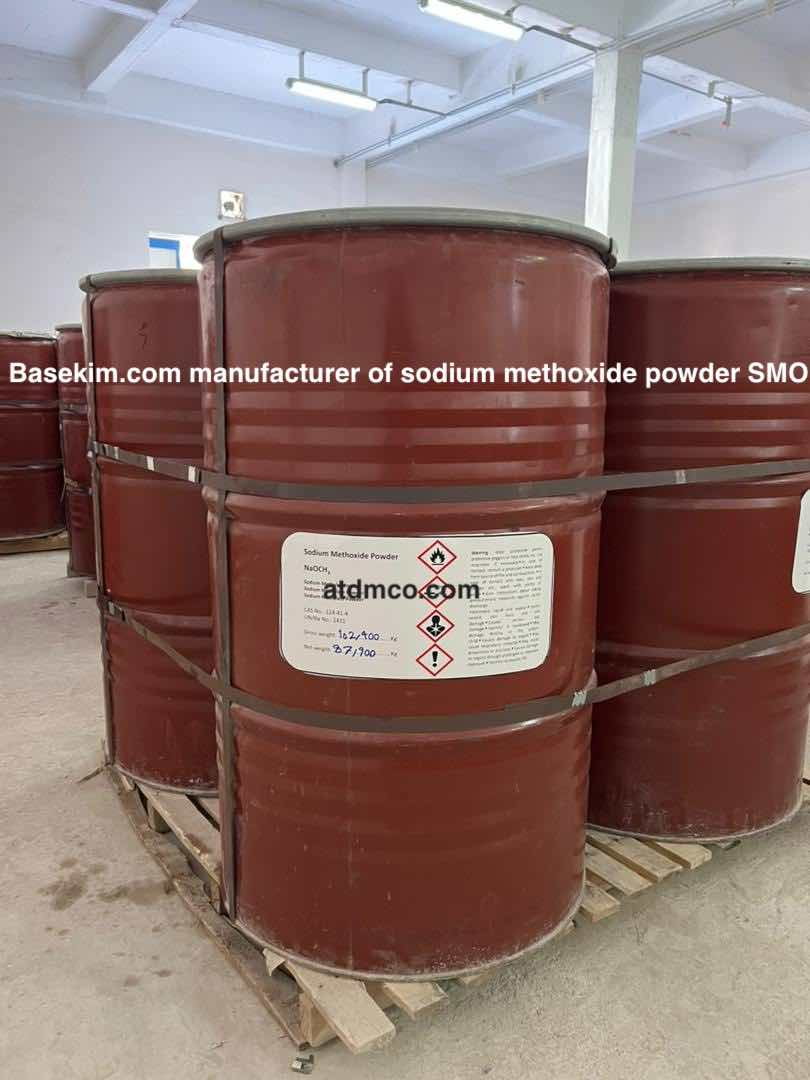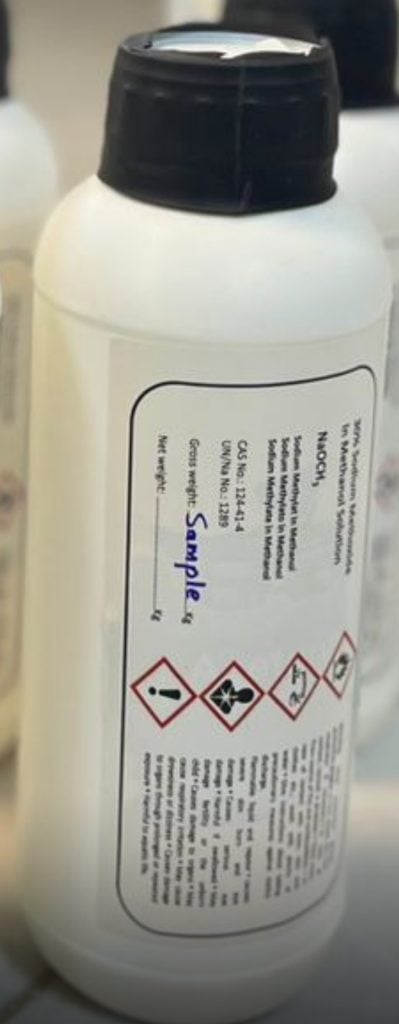
Sodium methoxide powder and liquid manufacturer
- Home
- Sodium methoxide powder and liquid manufacturer

Sodium Methoxide manufacturer in Turkey
Sodium methoxide is a highly versatile chemical compound used in various industries. It plays a crucial role in organic synthesis, pharmaceuticals, and biodiesel production. This compound is created by the reaction of sodium with methanol, resulting in a powerful base and nucleophile. Understanding sodium methoxide’s properties, applications, and safety measures is essential for its effective and safe use in industrial processes.
What is Sodium Methoxide?
Definition and Overview
Generally Sodium methoxide known as sodium methylate meanwhile is a chemical compound with the formula CH3ONa. It is formed by the reaction of sodium with methanol. This reaction yields a colorless or pale yellow solution, which is a potent base and nucleophile. It is widely utilized in organic synthesis, the pharmaceutical industry, and biodiesel production due to its reactive properties.
Table of Contents
ToggleChemical Identity
The chemical identity of sodium methoxide is defined by its unique characteristics. The chemical formula is CH3NaO in CH3OH, and it has a CAS number of 124-41-4 and 67-56-1 for methanol.
In the meantime molecular weight is 54.02 g/mol, while methanol has a molecular weight of 32.04 g/mol. The compound decomposes at a boiling point of 350 °C (662 °F; 623 K).
Physical and Chemical Properties
Physically, sodium methoxide appears as a colorless to pale yellow liquid, with a characteristic alcohol-like odor. Therefore It is fully soluble in ethanol and methanol but insoluble in hydrocarbons. The density of the solution is approximately 0.89 g/cm³. These properties make it highly effective in various chemical reactions and industrial applications.
Price of Sodium Methoxide
Market Trends
The price of sodium methoxide is influenced by various market trends. As of June 23, 2024, the market price is $1500 USD per metric ton (FOB value), with an additional $200 USD depending on purity and order quantity. Staying inform about these trends is crucial for stakeholders involve in procurement, investment, and strategic planning.
Factors Influencing Price
Several factors affect the price , including raw material costs, production processes, and market demand. The purity of the compound and the order quantity also play significant roles in determining its price. Understanding these dynamics helps businesses make informed decisions regarding their use of SMO.
Packing of Sodium Methoxide for Shipment
Packaging Details
Sodium methoxide is typically packed in drums for shipment. To prevent oxidation, the drums are filled with nitrogen. Each 20ft container holds 80 drums, with each drum weighing 106 kg net. This careful packaging ensures the stability and safety of SMO during transportation.
Importance of Nitrogen Filling
Filling the drums with nitrogen is a crucial step in the packaging process. Nitrogen prevents the oxidation of sodium methoxide, maintaining its purity and reactivity. This measure is essential for preserving the quality of the compound, especially during long-distance shipments.
Specification of Sodium Methoxide
Composition and Purity
The Sodium methoxide is known for its high purity and specific composition. The moisture content, measured by Karl Fischer titration, is 0.25 %w/w. The purity of the compound ranges between 99.5% and 99%, with total alkalinity as sodium methoxide (NaOCH3) being 99.34 %w/w.
Specific Impurities
It contains trace amounts of impurities, including free alkalinity as NaOH (0.55 %w/w), sodium carbonate content (0.24 %w/w), chlorides (100 ppm), and iron content (not more than 10 ppm). The mercury content is nil, ensuring the compound’s safety for industrial applications.
MSDS of Sodium Methoxide
Handling Precautions
It is highly reactive, necessitating careful handling. It should be stored in a cool, dry place, away from moisture. Proper protective equipment, such as gloves and goggles, is essential when handling this compound to avoid exposure and accidents.
Potential Hazards
Exposure to SMO can cause severe skin and eye irritation. Inhalation of its vapors can lead to respiratory issues. It is crucial to follow safety protocols to minimize risks and ensure safe handling of this chemical compound.
Emergency Measures
In case of exposure, immediate measures should be taken. For skin contact, rinse thoroughly with water and seek medical attention. If inhaled, move to fresh air and consult a healthcare professional. Quick and effective response to exposure can prevent serious health issues.
Why Use 30% Sodium Methoxide in Methanol?

Advantages of 30% Solution
A 30% solution of sodium methylate in methanol is commonly used due to its efficiency and manageable reactivity. This concentration provides a good balance between reactivity and ease of handling, making it suitable for various chemical reactions and industrial applications.
Specific Industrial Applications
The 30% solution of sodium methylate is particularly effective in industrial applications such as biodiesel production and organic synthesis. Its strong base and nucleophilic properties facilitate deprotonation and nucleophilic substitution reactions, enhancing the efficiency of these processes.
Sodium methylate Structure and Melting Point
Molecular Structure
Sodium methylate consists of a sodium (Na) ion bonded to a methoxide ion (CH3O-). The molecular structure can be depicted as Na+ – O-CH3, where the methoxide ion is formed by the deprotonation of methanol (CH3OH).
Melting Point and Physical Form
It has a melting point of approximately 127-128°C (260-262°F). It appears as a white to off-white crystalline powder and is highly reactive, especially in the presence of moisture, where it reacts to form methanol and sodium hydroxide.
Differences Between Solid Sodium Methoxide and Solution
Key Differences Summary
Solid sodium methylate and its solution form have distinct characteristics. It is a white to light yellow solid with higher purity and reactivity, requiring careful handling and storage in airtight containers. In contrast, the solution form is a colorless to slightly yellow liquid with lower purity but easier handling and storage requirements.
| Feature | Solid Sodium Methoxide | Sodium Methoxide Solution |
|---|---|---|
| Physical state | Solid | Liquid |
| Purity | Generally higher | Lower purity |
| Reactivity | Highly reactive | Less reactive |
| Handling | Difficult | Easier |
| Storage | Airtight containers | Less stringent |
Industrial Applications of SMO
Organic Synthesis
In organic synthesis, SMO serves as a strong base. It is essential in the production of numerous chemicals and pharmaceuticals. Its ability to deprotonate compounds makes it invaluable in forming carbon-carbon bonds.
Pharmaceuticals
The pharmaceutical industry relies heavily on SMO. It aids in the synthesis of active pharmaceutical ingredients (APIs). Its role in forming ester and ether bonds is crucial for developing new medications.
Biodiesel Production
SMO is a key catalyst in biodiesel production. It helps convert triglycerides into biodiesel through transesterification. This process is vital for creating sustainable fuel alternatives.
Benefits of Using Sodium Methoxide
Efficiency in Chemical Reactions
Sodium methoxide enhances the efficiency of chemical reactions. Its strong basicity allows for quicker reaction times and higher yields. This efficiency is particularly beneficial in large-scale industrial applications.
Cost-Effectiveness
Using sodium methoxide is cost-effective for many industries. It reduces the need for expensive catalysts and reaction conditions. This cost efficiency is crucial for maintaining profitability in competitive markets.
Environmental Impact
Sodium methoxide contributes to environmentally friendly processes. In biodiesel production, it facilitates the use of renewable resources. This reduces the carbon footprint of fuel production.
Conclusion
Sodium methoxide is an indispensable compound in various industries. Its role in organic synthesis, pharmaceuticals, and biodiesel production highlights its versatility. While it is offering numerous benefits, safety precautions are essential. Proper handling and awareness of potential hazards ensure safe and efficient use. This guide provides an overview of sodium methoxide, its applications, benefits, and safety measures.
FAQs
What is sodium methoxide use for? Sodium methoxide is use in organic synthesis, pharmaceutical manufacturing, and as a catalyst in biodiesel production.
How should sodium methoxide store? Sodium methoxide should store in a cool, dry place, away from moisture, in airtight containers to prevent oxidation and moisture absorption.
What are the hazards of SMO? Can cause severe skin and eye irritation and respiratory issues if inhaled. Proper safety measures should be followed to avoid exposure.
Why is a 30% solution of SMO used in methanol? A 30% solution offers a balance between reactivity and ease of handling, making it suitable for various industrial applications, including biodiesel production and organic synthesis.
How does SMO contribute to biodiesel production? Acts as a catalyst in the transesterification process, converting triglycerides into biodiesel, a sustainable fuel alternative.
What is the difference between SMO methoxide and its solution? Solid SMO is more reactive and requires careful handling and storage, while the solution form is easier to handle and store but has lower purity.
MSDS
Download MSDS of Sodium Methoxide
Specification
Download Specification of Sodium Methoxide
Contact Info
Turkey office:No.6 of Fahrettin Pasa Sokak , Galip Erdem steet, Ilkbahar Mah. Turan Gunes Ave. Çankaya Ankara
Phone: 00903125147055
Dubai office: 3509 of the Burligton tower, business bay, dubai-uae
Phone:0097142369830
E-Mail: [email protected]
